SOC 103A: Bachelor of Applied Social Science
VerifiedAdded on 2021/09/12
|8
|1917
|79
AI Summary
Contribute Materials
Your contribution can guide someone’s learning journey. Share your
documents today.
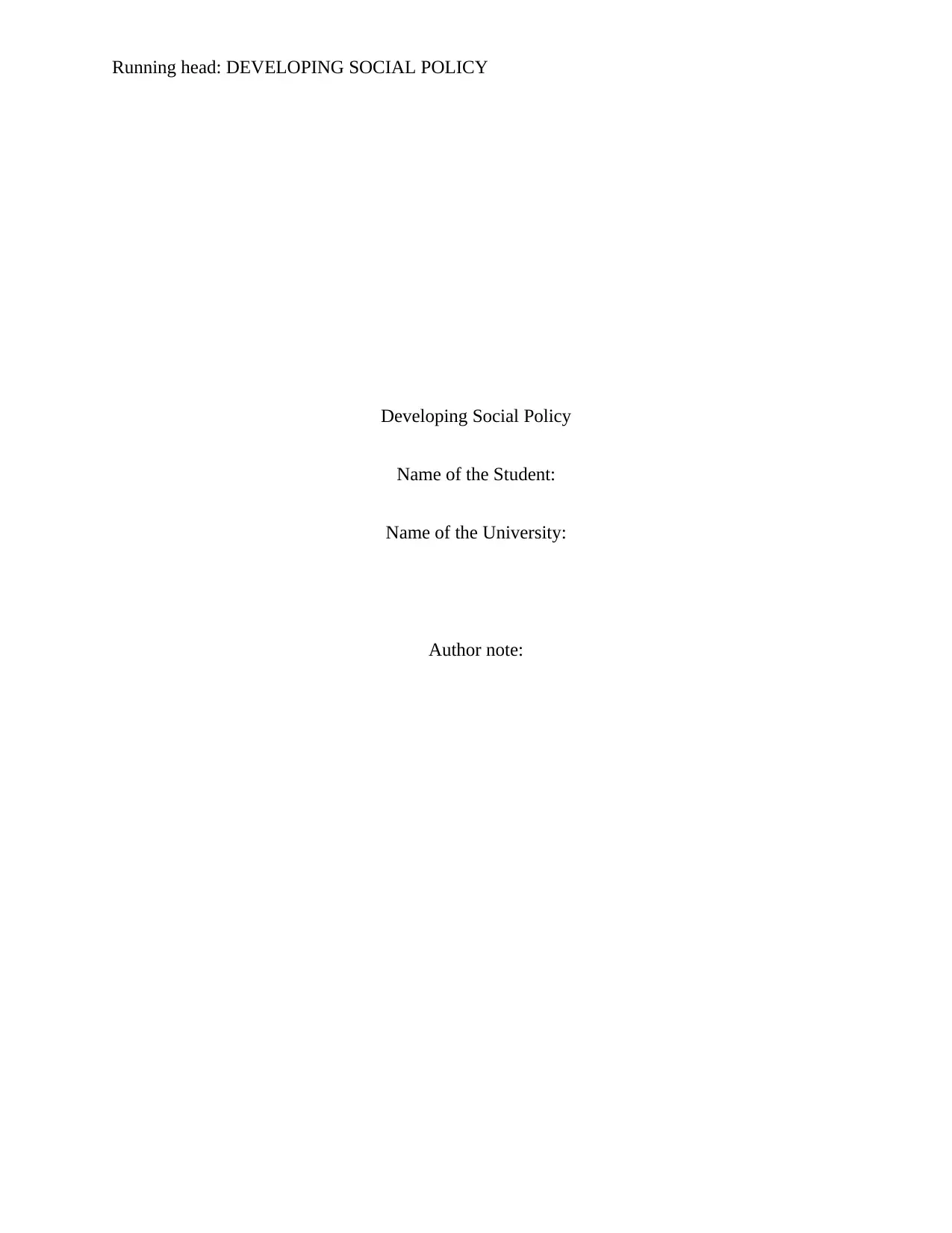
Running head: DEVELOPING SOCIAL POLICY
Developing Social Policy
Name of the Student:
Name of the University:
Author note:
Developing Social Policy
Name of the Student:
Name of the University:
Author note:
Secure Best Marks with AI Grader
Need help grading? Try our AI Grader for instant feedback on your assignments.
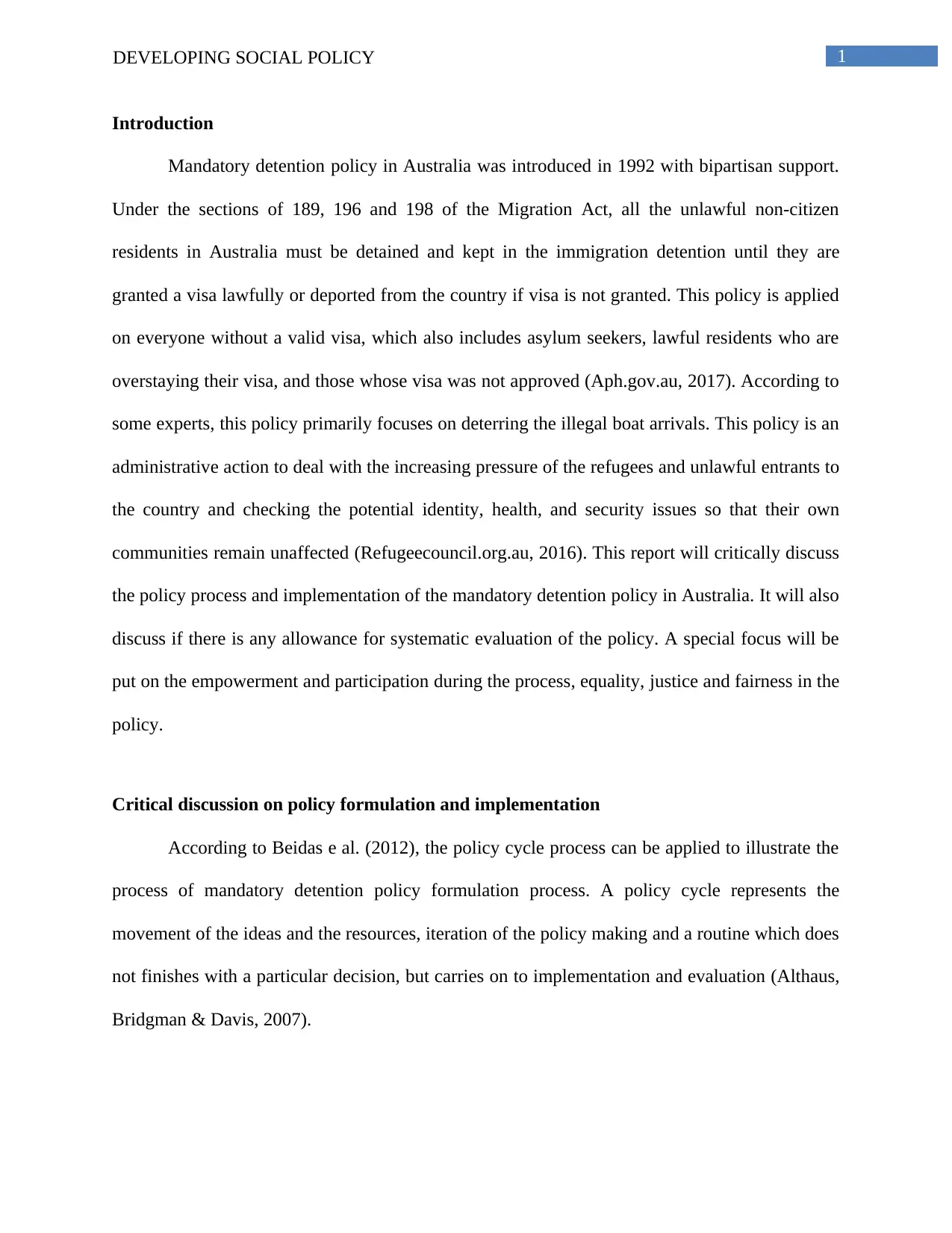
1DEVELOPING SOCIAL POLICY
Introduction
Mandatory detention policy in Australia was introduced in 1992 with bipartisan support.
Under the sections of 189, 196 and 198 of the Migration Act, all the unlawful non-citizen
residents in Australia must be detained and kept in the immigration detention until they are
granted a visa lawfully or deported from the country if visa is not granted. This policy is applied
on everyone without a valid visa, which also includes asylum seekers, lawful residents who are
overstaying their visa, and those whose visa was not approved (Aph.gov.au, 2017). According to
some experts, this policy primarily focuses on deterring the illegal boat arrivals. This policy is an
administrative action to deal with the increasing pressure of the refugees and unlawful entrants to
the country and checking the potential identity, health, and security issues so that their own
communities remain unaffected (Refugeecouncil.org.au, 2016). This report will critically discuss
the policy process and implementation of the mandatory detention policy in Australia. It will also
discuss if there is any allowance for systematic evaluation of the policy. A special focus will be
put on the empowerment and participation during the process, equality, justice and fairness in the
policy.
Critical discussion on policy formulation and implementation
According to Beidas e al. (2012), the policy cycle process can be applied to illustrate the
process of mandatory detention policy formulation process. A policy cycle represents the
movement of the ideas and the resources, iteration of the policy making and a routine which does
not finishes with a particular decision, but carries on to implementation and evaluation (Althaus,
Bridgman & Davis, 2007).
Introduction
Mandatory detention policy in Australia was introduced in 1992 with bipartisan support.
Under the sections of 189, 196 and 198 of the Migration Act, all the unlawful non-citizen
residents in Australia must be detained and kept in the immigration detention until they are
granted a visa lawfully or deported from the country if visa is not granted. This policy is applied
on everyone without a valid visa, which also includes asylum seekers, lawful residents who are
overstaying their visa, and those whose visa was not approved (Aph.gov.au, 2017). According to
some experts, this policy primarily focuses on deterring the illegal boat arrivals. This policy is an
administrative action to deal with the increasing pressure of the refugees and unlawful entrants to
the country and checking the potential identity, health, and security issues so that their own
communities remain unaffected (Refugeecouncil.org.au, 2016). This report will critically discuss
the policy process and implementation of the mandatory detention policy in Australia. It will also
discuss if there is any allowance for systematic evaluation of the policy. A special focus will be
put on the empowerment and participation during the process, equality, justice and fairness in the
policy.
Critical discussion on policy formulation and implementation
According to Beidas e al. (2012), the policy cycle process can be applied to illustrate the
process of mandatory detention policy formulation process. A policy cycle represents the
movement of the ideas and the resources, iteration of the policy making and a routine which does
not finishes with a particular decision, but carries on to implementation and evaluation (Althaus,
Bridgman & Davis, 2007).
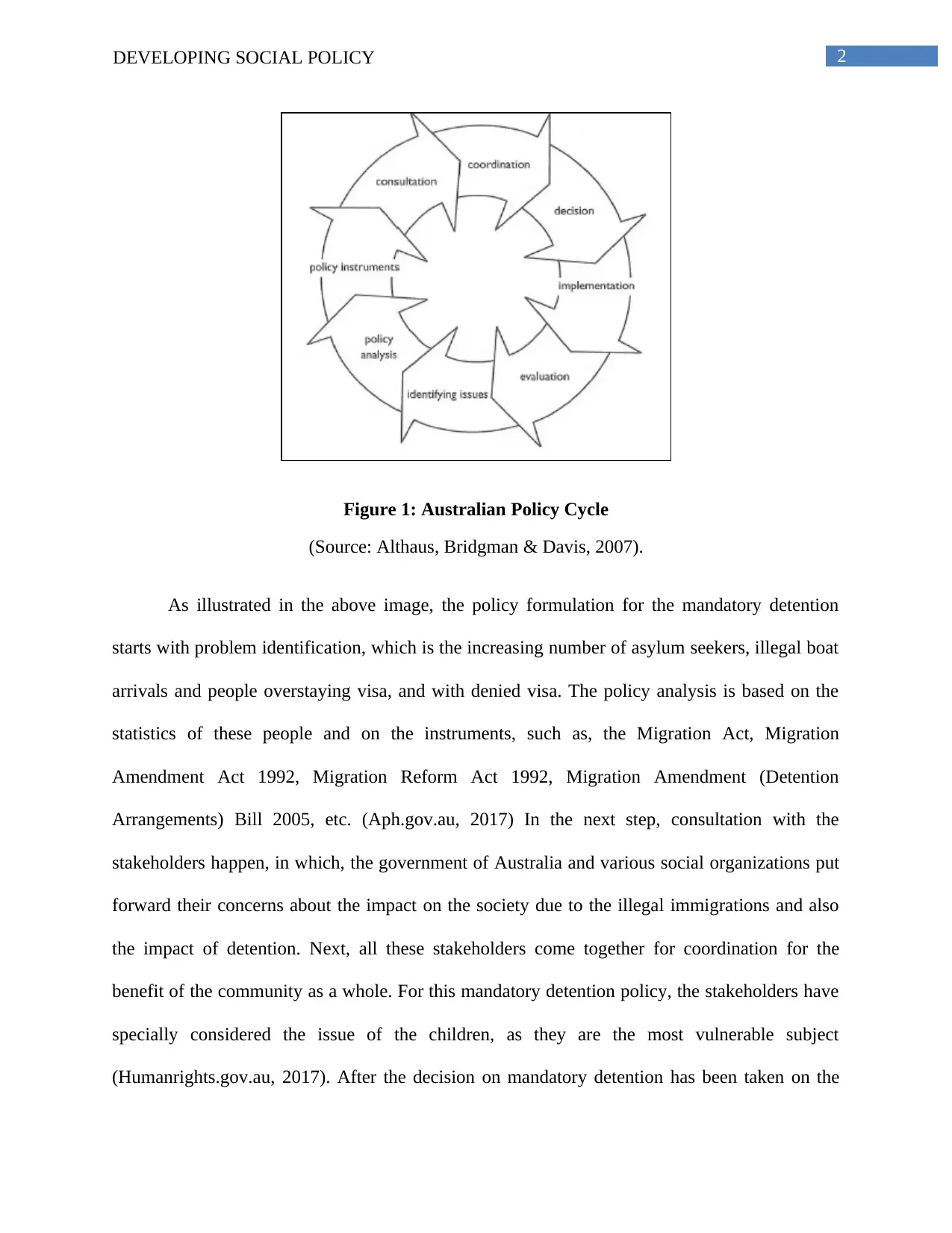
2DEVELOPING SOCIAL POLICY
Figure 1: Australian Policy Cycle
(Source: Althaus, Bridgman & Davis, 2007).
As illustrated in the above image, the policy formulation for the mandatory detention
starts with problem identification, which is the increasing number of asylum seekers, illegal boat
arrivals and people overstaying visa, and with denied visa. The policy analysis is based on the
statistics of these people and on the instruments, such as, the Migration Act, Migration
Amendment Act 1992, Migration Reform Act 1992, Migration Amendment (Detention
Arrangements) Bill 2005, etc. (Aph.gov.au, 2017) In the next step, consultation with the
stakeholders happen, in which, the government of Australia and various social organizations put
forward their concerns about the impact on the society due to the illegal immigrations and also
the impact of detention. Next, all these stakeholders come together for coordination for the
benefit of the community as a whole. For this mandatory detention policy, the stakeholders have
specially considered the issue of the children, as they are the most vulnerable subject
(Humanrights.gov.au, 2017). After the decision on mandatory detention has been taken on the
Figure 1: Australian Policy Cycle
(Source: Althaus, Bridgman & Davis, 2007).
As illustrated in the above image, the policy formulation for the mandatory detention
starts with problem identification, which is the increasing number of asylum seekers, illegal boat
arrivals and people overstaying visa, and with denied visa. The policy analysis is based on the
statistics of these people and on the instruments, such as, the Migration Act, Migration
Amendment Act 1992, Migration Reform Act 1992, Migration Amendment (Detention
Arrangements) Bill 2005, etc. (Aph.gov.au, 2017) In the next step, consultation with the
stakeholders happen, in which, the government of Australia and various social organizations put
forward their concerns about the impact on the society due to the illegal immigrations and also
the impact of detention. Next, all these stakeholders come together for coordination for the
benefit of the community as a whole. For this mandatory detention policy, the stakeholders have
specially considered the issue of the children, as they are the most vulnerable subject
(Humanrights.gov.au, 2017). After the decision on mandatory detention has been taken on the
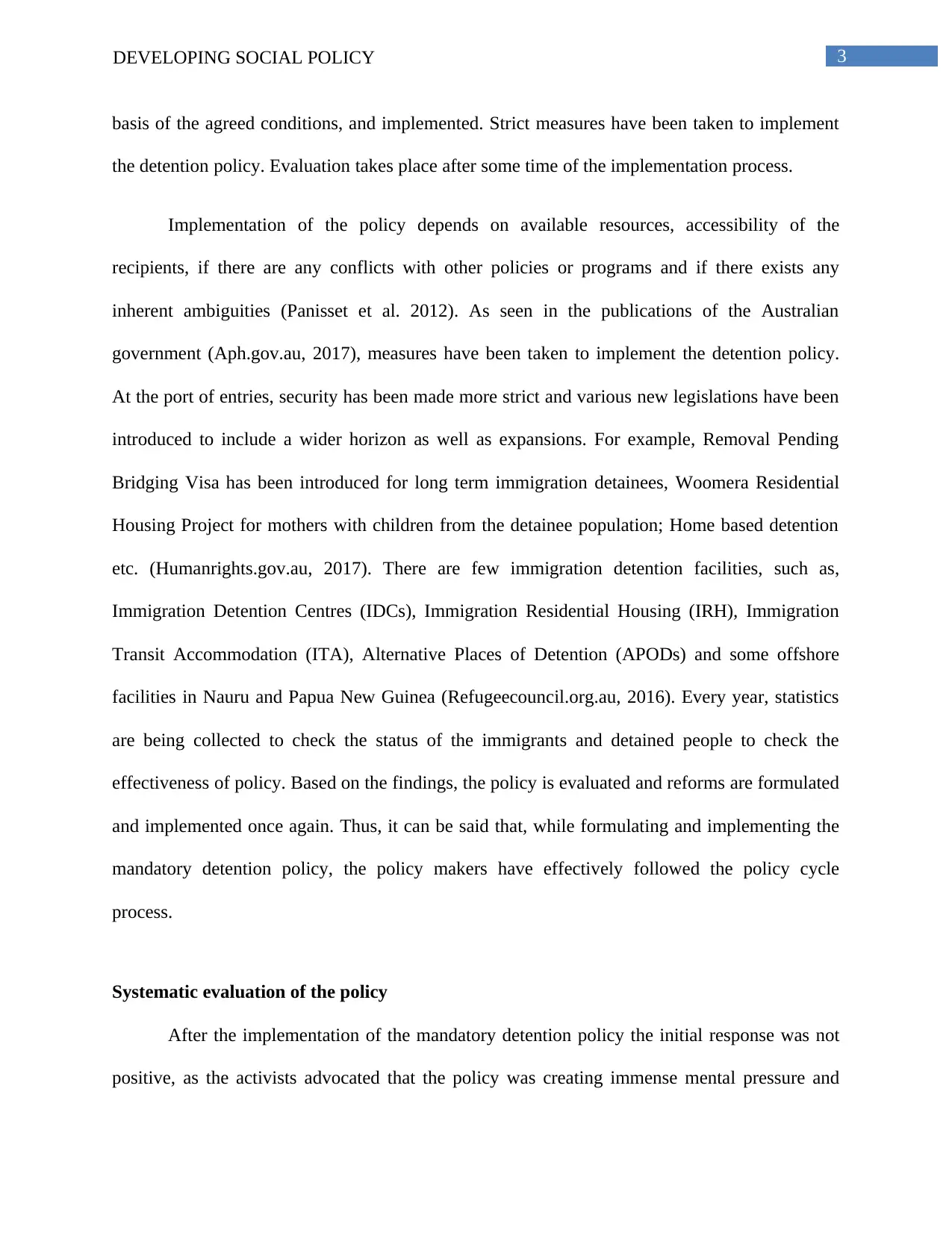
3DEVELOPING SOCIAL POLICY
basis of the agreed conditions, and implemented. Strict measures have been taken to implement
the detention policy. Evaluation takes place after some time of the implementation process.
Implementation of the policy depends on available resources, accessibility of the
recipients, if there are any conflicts with other policies or programs and if there exists any
inherent ambiguities (Panisset et al. 2012). As seen in the publications of the Australian
government (Aph.gov.au, 2017), measures have been taken to implement the detention policy.
At the port of entries, security has been made more strict and various new legislations have been
introduced to include a wider horizon as well as expansions. For example, Removal Pending
Bridging Visa has been introduced for long term immigration detainees, Woomera Residential
Housing Project for mothers with children from the detainee population; Home based detention
etc. (Humanrights.gov.au, 2017). There are few immigration detention facilities, such as,
Immigration Detention Centres (IDCs), Immigration Residential Housing (IRH), Immigration
Transit Accommodation (ITA), Alternative Places of Detention (APODs) and some offshore
facilities in Nauru and Papua New Guinea (Refugeecouncil.org.au, 2016). Every year, statistics
are being collected to check the status of the immigrants and detained people to check the
effectiveness of policy. Based on the findings, the policy is evaluated and reforms are formulated
and implemented once again. Thus, it can be said that, while formulating and implementing the
mandatory detention policy, the policy makers have effectively followed the policy cycle
process.
Systematic evaluation of the policy
After the implementation of the mandatory detention policy the initial response was not
positive, as the activists advocated that the policy was creating immense mental pressure and
basis of the agreed conditions, and implemented. Strict measures have been taken to implement
the detention policy. Evaluation takes place after some time of the implementation process.
Implementation of the policy depends on available resources, accessibility of the
recipients, if there are any conflicts with other policies or programs and if there exists any
inherent ambiguities (Panisset et al. 2012). As seen in the publications of the Australian
government (Aph.gov.au, 2017), measures have been taken to implement the detention policy.
At the port of entries, security has been made more strict and various new legislations have been
introduced to include a wider horizon as well as expansions. For example, Removal Pending
Bridging Visa has been introduced for long term immigration detainees, Woomera Residential
Housing Project for mothers with children from the detainee population; Home based detention
etc. (Humanrights.gov.au, 2017). There are few immigration detention facilities, such as,
Immigration Detention Centres (IDCs), Immigration Residential Housing (IRH), Immigration
Transit Accommodation (ITA), Alternative Places of Detention (APODs) and some offshore
facilities in Nauru and Papua New Guinea (Refugeecouncil.org.au, 2016). Every year, statistics
are being collected to check the status of the immigrants and detained people to check the
effectiveness of policy. Based on the findings, the policy is evaluated and reforms are formulated
and implemented once again. Thus, it can be said that, while formulating and implementing the
mandatory detention policy, the policy makers have effectively followed the policy cycle
process.
Systematic evaluation of the policy
After the implementation of the mandatory detention policy the initial response was not
positive, as the activists advocated that the policy was creating immense mental pressure and
Secure Best Marks with AI Grader
Need help grading? Try our AI Grader for instant feedback on your assignments.
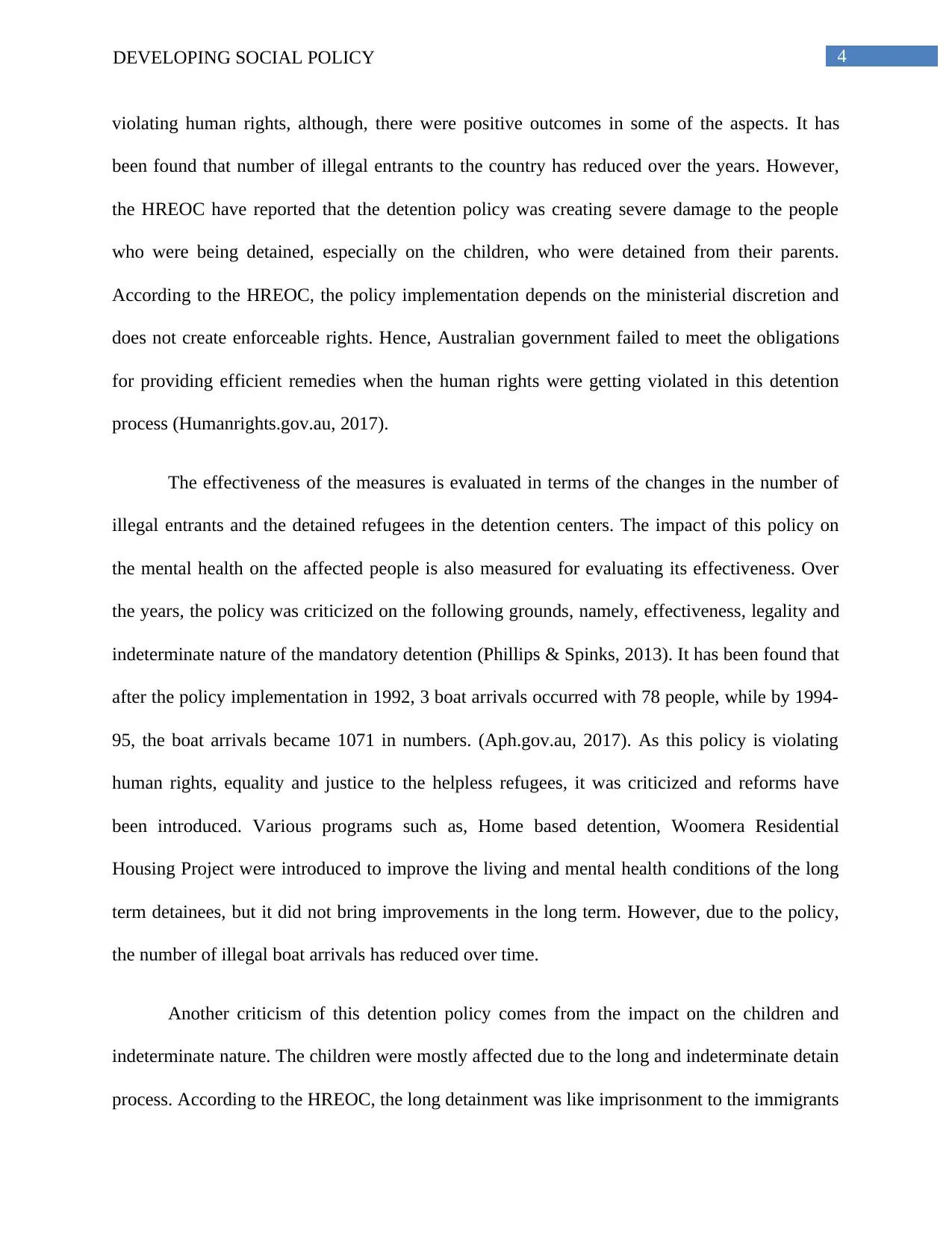
4DEVELOPING SOCIAL POLICY
violating human rights, although, there were positive outcomes in some of the aspects. It has
been found that number of illegal entrants to the country has reduced over the years. However,
the HREOC have reported that the detention policy was creating severe damage to the people
who were being detained, especially on the children, who were detained from their parents.
According to the HREOC, the policy implementation depends on the ministerial discretion and
does not create enforceable rights. Hence, Australian government failed to meet the obligations
for providing efficient remedies when the human rights were getting violated in this detention
process (Humanrights.gov.au, 2017).
The effectiveness of the measures is evaluated in terms of the changes in the number of
illegal entrants and the detained refugees in the detention centers. The impact of this policy on
the mental health on the affected people is also measured for evaluating its effectiveness. Over
the years, the policy was criticized on the following grounds, namely, effectiveness, legality and
indeterminate nature of the mandatory detention (Phillips & Spinks, 2013). It has been found that
after the policy implementation in 1992, 3 boat arrivals occurred with 78 people, while by 1994-
95, the boat arrivals became 1071 in numbers. (Aph.gov.au, 2017). As this policy is violating
human rights, equality and justice to the helpless refugees, it was criticized and reforms have
been introduced. Various programs such as, Home based detention, Woomera Residential
Housing Project were introduced to improve the living and mental health conditions of the long
term detainees, but it did not bring improvements in the long term. However, due to the policy,
the number of illegal boat arrivals has reduced over time.
Another criticism of this detention policy comes from the impact on the children and
indeterminate nature. The children were mostly affected due to the long and indeterminate detain
process. According to the HREOC, the long detainment was like imprisonment to the immigrants
violating human rights, although, there were positive outcomes in some of the aspects. It has
been found that number of illegal entrants to the country has reduced over the years. However,
the HREOC have reported that the detention policy was creating severe damage to the people
who were being detained, especially on the children, who were detained from their parents.
According to the HREOC, the policy implementation depends on the ministerial discretion and
does not create enforceable rights. Hence, Australian government failed to meet the obligations
for providing efficient remedies when the human rights were getting violated in this detention
process (Humanrights.gov.au, 2017).
The effectiveness of the measures is evaluated in terms of the changes in the number of
illegal entrants and the detained refugees in the detention centers. The impact of this policy on
the mental health on the affected people is also measured for evaluating its effectiveness. Over
the years, the policy was criticized on the following grounds, namely, effectiveness, legality and
indeterminate nature of the mandatory detention (Phillips & Spinks, 2013). It has been found that
after the policy implementation in 1992, 3 boat arrivals occurred with 78 people, while by 1994-
95, the boat arrivals became 1071 in numbers. (Aph.gov.au, 2017). As this policy is violating
human rights, equality and justice to the helpless refugees, it was criticized and reforms have
been introduced. Various programs such as, Home based detention, Woomera Residential
Housing Project were introduced to improve the living and mental health conditions of the long
term detainees, but it did not bring improvements in the long term. However, due to the policy,
the number of illegal boat arrivals has reduced over time.
Another criticism of this detention policy comes from the impact on the children and
indeterminate nature. The children were mostly affected due to the long and indeterminate detain
process. According to the HREOC, the long detainment was like imprisonment to the immigrants

5DEVELOPING SOCIAL POLICY
and it had a negative impact on their well being. As highlighted by Doherty (2016) in his report,
the detention centers in Nauru and Manus are creating havoc damages to the asylum seekers
through various activities that violate human rights. The poor healthcare systems also led to
some deaths every year. Although, the government of Australia have reported that the detainees
are treated with dignity, respect and humanity and hence, the rate of absconding from the
detention centers are very less. Between July 2005 and September 2008, only 2 out of 244
detainees in Community Care Pilot detention center absconded and 1 out of 370 detainees from
Immigration Residential Housing absconded (Humanrights.gov.au, 2014). Thus, it can be said
that the policies and the officials implement justice, fairness, equality, and empowerment to the
detained immigrants, which also resulted in voluntary participation and coordination from the
detainees.
Conclusion
The mandatory detention policy of Australia is an important policy that deals with the
illegal immigrants to the country. Various measures have been taken since its inception in 1992
to reduce the number of illegal immigrants, and after evaluating the effectiveness of the initial
measures, various reforms were also implemented to improve the conditions of the asylum
seekers, unauthorized boat arrivals, people with cancelled visa and expired visa. It has been
found that due to this policy, many asylum seekers were separated from their families and sent to
a third country, children were affected severely and several human rights violating activities take
place secretly in the detention centers, which have a negative impact. However, the policy was
successful in reducing the number of illegal immigration in Australia.
and it had a negative impact on their well being. As highlighted by Doherty (2016) in his report,
the detention centers in Nauru and Manus are creating havoc damages to the asylum seekers
through various activities that violate human rights. The poor healthcare systems also led to
some deaths every year. Although, the government of Australia have reported that the detainees
are treated with dignity, respect and humanity and hence, the rate of absconding from the
detention centers are very less. Between July 2005 and September 2008, only 2 out of 244
detainees in Community Care Pilot detention center absconded and 1 out of 370 detainees from
Immigration Residential Housing absconded (Humanrights.gov.au, 2014). Thus, it can be said
that the policies and the officials implement justice, fairness, equality, and empowerment to the
detained immigrants, which also resulted in voluntary participation and coordination from the
detainees.
Conclusion
The mandatory detention policy of Australia is an important policy that deals with the
illegal immigrants to the country. Various measures have been taken since its inception in 1992
to reduce the number of illegal immigrants, and after evaluating the effectiveness of the initial
measures, various reforms were also implemented to improve the conditions of the asylum
seekers, unauthorized boat arrivals, people with cancelled visa and expired visa. It has been
found that due to this policy, many asylum seekers were separated from their families and sent to
a third country, children were affected severely and several human rights violating activities take
place secretly in the detention centers, which have a negative impact. However, the policy was
successful in reducing the number of illegal immigration in Australia.
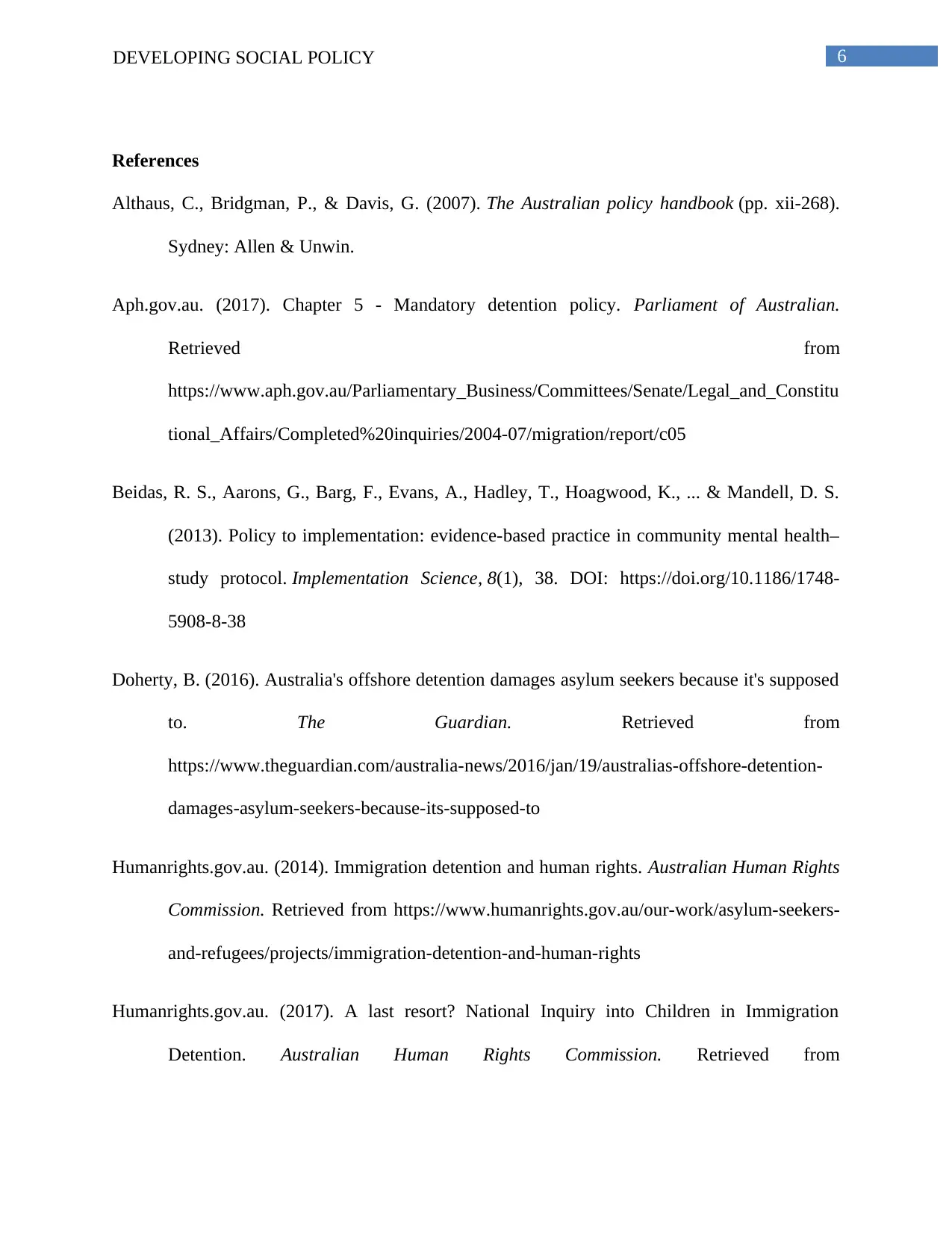
6DEVELOPING SOCIAL POLICY
References
Althaus, C., Bridgman, P., & Davis, G. (2007). The Australian policy handbook (pp. xii-268).
Sydney: Allen & Unwin.
Aph.gov.au. (2017). Chapter 5 - Mandatory detention policy. Parliament of Australian.
Retrieved from
https://www.aph.gov.au/Parliamentary_Business/Committees/Senate/Legal_and_Constitu
tional_Affairs/Completed%20inquiries/2004-07/migration/report/c05
Beidas, R. S., Aarons, G., Barg, F., Evans, A., Hadley, T., Hoagwood, K., ... & Mandell, D. S.
(2013). Policy to implementation: evidence-based practice in community mental health–
study protocol. Implementation Science, 8(1), 38. DOI: https://doi.org/10.1186/1748-
5908-8-38
Doherty, B. (2016). Australia's offshore detention damages asylum seekers because it's supposed
to. The Guardian. Retrieved from
https://www.theguardian.com/australia-news/2016/jan/19/australias-offshore-detention-
damages-asylum-seekers-because-its-supposed-to
Humanrights.gov.au. (2014). Immigration detention and human rights. Australian Human Rights
Commission. Retrieved from https://www.humanrights.gov.au/our-work/asylum-seekers-
and-refugees/projects/immigration-detention-and-human-rights
Humanrights.gov.au. (2017). A last resort? National Inquiry into Children in Immigration
Detention. Australian Human Rights Commission. Retrieved from
References
Althaus, C., Bridgman, P., & Davis, G. (2007). The Australian policy handbook (pp. xii-268).
Sydney: Allen & Unwin.
Aph.gov.au. (2017). Chapter 5 - Mandatory detention policy. Parliament of Australian.
Retrieved from
https://www.aph.gov.au/Parliamentary_Business/Committees/Senate/Legal_and_Constitu
tional_Affairs/Completed%20inquiries/2004-07/migration/report/c05
Beidas, R. S., Aarons, G., Barg, F., Evans, A., Hadley, T., Hoagwood, K., ... & Mandell, D. S.
(2013). Policy to implementation: evidence-based practice in community mental health–
study protocol. Implementation Science, 8(1), 38. DOI: https://doi.org/10.1186/1748-
5908-8-38
Doherty, B. (2016). Australia's offshore detention damages asylum seekers because it's supposed
to. The Guardian. Retrieved from
https://www.theguardian.com/australia-news/2016/jan/19/australias-offshore-detention-
damages-asylum-seekers-because-its-supposed-to
Humanrights.gov.au. (2014). Immigration detention and human rights. Australian Human Rights
Commission. Retrieved from https://www.humanrights.gov.au/our-work/asylum-seekers-
and-refugees/projects/immigration-detention-and-human-rights
Humanrights.gov.au. (2017). A last resort? National Inquiry into Children in Immigration
Detention. Australian Human Rights Commission. Retrieved from
Paraphrase This Document
Need a fresh take? Get an instant paraphrase of this document with our AI Paraphraser
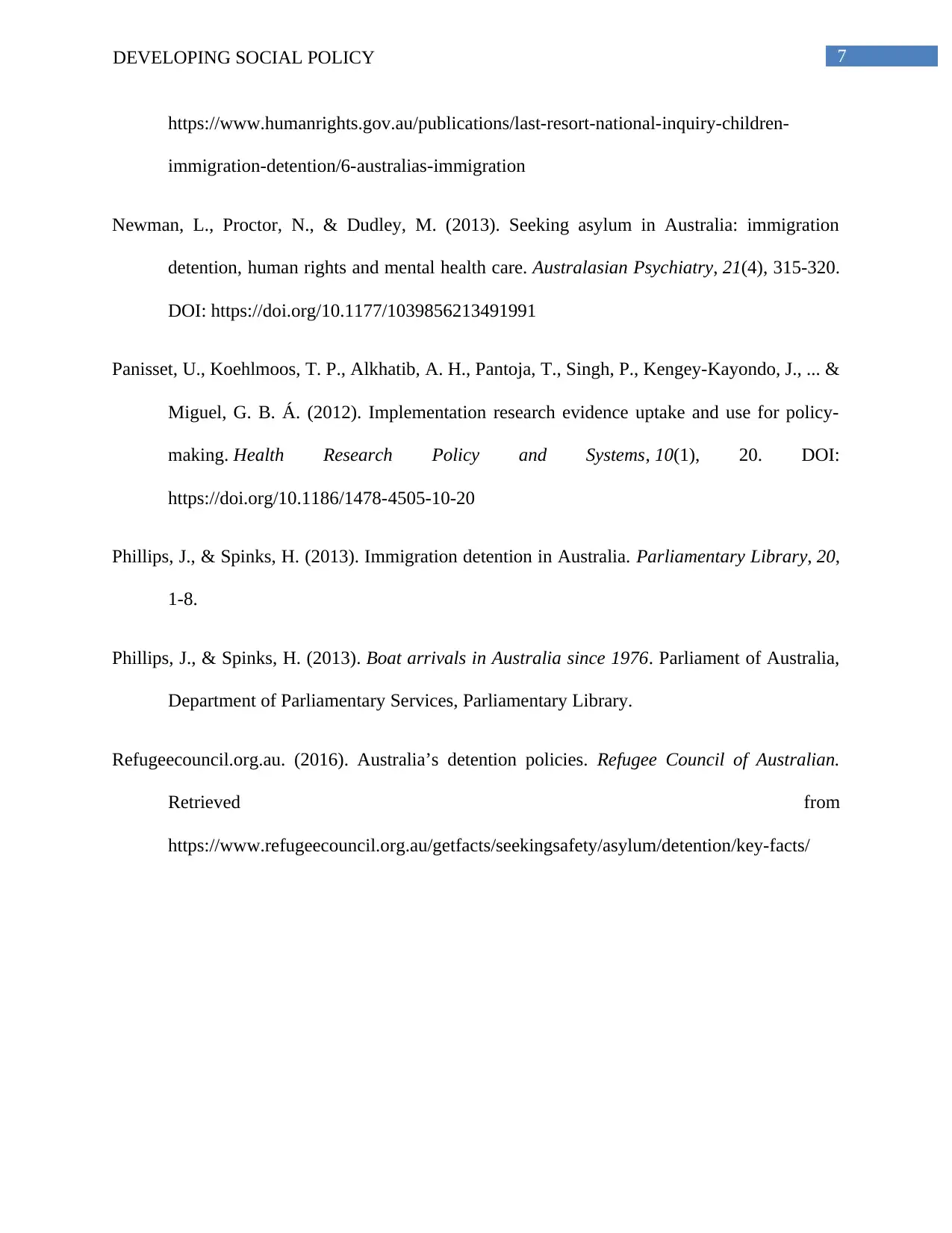
7DEVELOPING SOCIAL POLICY
https://www.humanrights.gov.au/publications/last-resort-national-inquiry-children-
immigration-detention/6-australias-immigration
Newman, L., Proctor, N., & Dudley, M. (2013). Seeking asylum in Australia: immigration
detention, human rights and mental health care. Australasian Psychiatry, 21(4), 315-320.
DOI: https://doi.org/10.1177/1039856213491991
Panisset, U., Koehlmoos, T. P., Alkhatib, A. H., Pantoja, T., Singh, P., Kengey-Kayondo, J., ... &
Miguel, G. B. Á. (2012). Implementation research evidence uptake and use for policy-
making. Health Research Policy and Systems, 10(1), 20. DOI:
https://doi.org/10.1186/1478-4505-10-20
Phillips, J., & Spinks, H. (2013). Immigration detention in Australia. Parliamentary Library, 20,
1-8.
Phillips, J., & Spinks, H. (2013). Boat arrivals in Australia since 1976. Parliament of Australia,
Department of Parliamentary Services, Parliamentary Library.
Refugeecouncil.org.au. (2016). Australia’s detention policies. Refugee Council of Australian.
Retrieved from
https://www.refugeecouncil.org.au/getfacts/seekingsafety/asylum/detention/key-facts/
https://www.humanrights.gov.au/publications/last-resort-national-inquiry-children-
immigration-detention/6-australias-immigration
Newman, L., Proctor, N., & Dudley, M. (2013). Seeking asylum in Australia: immigration
detention, human rights and mental health care. Australasian Psychiatry, 21(4), 315-320.
DOI: https://doi.org/10.1177/1039856213491991
Panisset, U., Koehlmoos, T. P., Alkhatib, A. H., Pantoja, T., Singh, P., Kengey-Kayondo, J., ... &
Miguel, G. B. Á. (2012). Implementation research evidence uptake and use for policy-
making. Health Research Policy and Systems, 10(1), 20. DOI:
https://doi.org/10.1186/1478-4505-10-20
Phillips, J., & Spinks, H. (2013). Immigration detention in Australia. Parliamentary Library, 20,
1-8.
Phillips, J., & Spinks, H. (2013). Boat arrivals in Australia since 1976. Parliament of Australia,
Department of Parliamentary Services, Parliamentary Library.
Refugeecouncil.org.au. (2016). Australia’s detention policies. Refugee Council of Australian.
Retrieved from
https://www.refugeecouncil.org.au/getfacts/seekingsafety/asylum/detention/key-facts/
1 out of 8
Related Documents
Your All-in-One AI-Powered Toolkit for Academic Success.
+13062052269
info@desklib.com
Available 24*7 on WhatsApp / Email
![[object Object]](/_next/static/media/star-bottom.7253800d.svg)
Unlock your academic potential
© 2024 | Zucol Services PVT LTD | All rights reserved.



